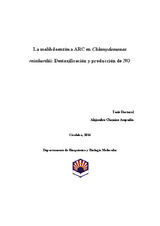La molibdoenzima ARC en Chalmydomonas reinhardtii: Destoxificación y producción de NO
Autor
Chamizo-Ampudia, Alejandro
Director/es
Fernández Reyes, EmilioLlamas Azúa, Ángel
Editor
Universidad de Córdoba, UCOPressFecha
2016Materia
NitrógenoAsimilación de nitrógeno
Molibdeno
Molibdoenzimas
Enzimas
Actividades enzimáticas
Chalamydomonas reinhardtii Molybdenium
METS:
Mostrar el registro METSPREMIS:
Mostrar el registro PREMISMetadatos
Mostrar el registro completo del ítemResumen
The ARC (amidoxime reducing component) protein was discovered in
2006 as a new molybdenum cofactor (Moco)-containing enzyme involved in
the reduction of N-hydroxylated compounds (NHC). Proteins of this family
are distributed throughout the three kingdoms of living organisms. In this
thesis we have identified the ARC protein of Chlamydomonas, and the
proteins that interact with it. The role of the ARC protein in regulating the
metabolic pathway of nitrate assimilation is proposed, the confirmation of a
prediction of its structure, and finally its capacity to store Moco have been
addressed.
Chapter I
The ARC protein is a new molybdoenzyme about which not much is
known. This protein is 329 amino acids long with two conserved domains
such as the β-barrel and the MOSC. This protein seems to have a role in
detoxifying of N-hydroxy compounds such as hydroxylamine purine (HAP),
which is a compound analogous to adenine and therefore mutagenic.
In this thesis, we have identified this ARC protein in Chlamydomonas
as a molybdoenzyme. Chlamydomonas mutants affected in this protein are
unable to develop the detoxification activity of HAP, which seems to depend
on Moco.
Two other proteins responsible for the transfer of electrons from
NADH to ARC were also identified. In bacteria this transfer occurs by a
ferredoxin domain and a reductase protein (CYSJ), whereas in humans by
Cytb5 and Cytb5-R. In Chlamydomonas, we have studied in vivo this
capability of transfer for the six ferredoxins and five Cytb5 from the alga, and...

